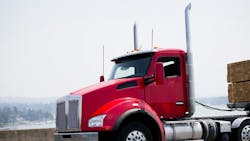Improving day-cab efficiency with aero devices
While many operators focus on efficiency for long-haul vehicles, the day cabs which handle short-haul transportation stand to benefit from efficiency improvements as well. After all, ACT Research estimates that 40% of all Class 8 tractors sold are day cabs, meaning that they deserve as much attention to reduce aerodynamic drag as their sleeper cab bretheren.
I believe operators of both sleeper tractors and day cabs want to operate as efficiently as possible and get the most miles out of a gallon of fuel. I also suspect far too many people in the trucking industry think that aerodynamic devices are only for sleeper tractors. They believe investing in aero devices on day cabs makes no sense.
They are mistaken.
In the first place, many erroneously believe there is no aerodynamic benefit at speeds under 50 mph. That simply is not true. There are still efficiency gains to be had, though payback could take longer. It is important to remember that for every 2% reduction in aerodynamic drag, there is approximately a 1% improvement in fuel economy. Even if a truck does not get a full 2% reduction in drag, it still can see some improvement.
See also: Fleets' growing concerns include cost, efficiency, and sustainability, Shell Fleet Solutions says
I would also guess that many fleets—especially regional ones—spend more time at highway speeds than they think. I challenge fleets to spend some time analyzing their data and looking at miles traveled at various speeds. Of course, there will be slower miles as they get closer to their delivery points, but unless they are in a 100% city delivery application, I bet they will find that their trucks are traveling at more than 50 MPH for long periods.
Additionally, there are plenty of opportunities for aerodynamic improvement when looking at the tractor-trailer as a complete unit. The tractor-trailer combination can be optimized for aerodynamic efficiency even if the tractor is a day cab. For instance, gap closure devices between the tractor and the trailer are particularly beneficial, as they tend to have higher gaps, creating more drag as the air hits the front of the trailer.
If you are operating day cabs, I encourage you to consider adding aerodynamic devices. I bet they will save you money.
This article was originally published on FleetOwner.com.
About the Author
Michael Roeth
Executive Director
Mike has worked in the commercial vehicle industry for nearly 30 years, most recently as the Executive Director of the North American Council for Freight Efficiency. Mike is also leading the Trucking Efficiency Operations for the Carbon War Room. Mike’s specialty is brokering green truck collaborative technologies into the real world at scale. He has a BS in Engineering from the Ohio State University and a Masters in Organizational Leadership from the Indiana Institute of Technology. Mike served as Chairman of the Board for the Truck Manufacturers Association, Board member of the Automotive Industry Action Group and currently serves on the second National Academy of Sciences Committee on Technologies and Approaches for Reducing the Fuel Consumption of Medium- and Heavy-Duty Vehicles and has held various positions in engineering, quality, sales and plant management with Navistar and Behr/Cummins.
